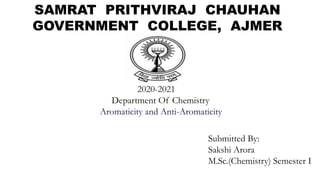
Aromaticity and Anti-Aromaticity
- 1. SAMRAT PRITHVIRAJ CHAUHAN GOVERNMENT COLLEGE, AJMER 2020-2021 Department Of Chemistry Aromaticity and Anti-Aromaticity Submitted By: Sakshi Arora M.Sc.(Chemistry) Semester I
- 2. Contents • Aromaticity • NMR Spectroscopy for Aromatic Compounds • Aromatic Compounds • Anti-Aromaticity • Non Aromatic Compounds • Reference
- 3. • Aromaticity is the ability of a compound to sustain induced diamagnetic ring current i.e. they are diatropic. • Planar, monocyclic, completely conjugated systems with (4n + 2) delocalisable π electrons all in bonding orbitals and are exceptionally stable. Such systems are said to be aromatic. • They undergo electrophilic substitution rather than addition reaction. • The rings of 2,6,10,14…. π electrons will be aromatic. • Delocalization energy of cyclic conjugated polyene system is greater than that of its acyclic analogue
- 4. Criteria for Aromaticity 1. The molecule must be cyclic To be aromatic, each p orbital must overlap with p orbitals on adjacent atoms. Benzene 1,3,5 Hexatriene Aromatic Not Aromatic 2. The molecule must be Conjugated
- 5. 3. The molecule must be planar All adjacent p orbitals must be aligned so that the π electron density can be delocalized. Benzene
- 6. 4. The molecule must follow Hückel's Rule i.e. it must have (4n+2)π electrons
- 7. • According to Hückel's Molecular Orbital Theory, a compound is particularly stable if all of its bonding molecular orbitals are filled with paired electrons. • With aromatic compounds, 2 electrons fill the lowest energy molecular orbital, and 4 electrons fill each subsequent energy level, leaving all bonding orbitals filled and no anti-bonding orbitals occupied. This gives a total of 4n+2π electrons. • Benzene has 6π electrons. Its first 2π electrons fill the lowest energy orbital, and it has 4π electrons remaining. These 4 fill in the orbitals of the succeeding energy level. Why 4n+2 π Electrons?
- 9. Why do aromatic compounds burns with sooty flame? • Aromatic compound burn with sooty flame because they have a ring structure of carbon atom. This causes incomplete combustion of the carbon chain. • They have relatively high percentage of carbon. • Thus they give sooty flame.
- 10. NMR Spectroscopy Of Aromatic Compounds • The protons above or within the aromatic ring are shielded and will be shifted upfield(lower δ ppm) • The protons outside the aromatic ring are deshielded and appear at a downfield position(higher δ ppm) • Ordinary alkene hydrogens are found at ~5-6 δ, while the hydrogens of aromatic ring are located at ~7-8 δ.
- 11. BENZENOID AROMATIC COMPOUNDS Naphthalene Anthracene Phenanthrene 10π electron system 14π electron system 14π electron system NON BENZENOID AROMATIC COMPOUNDS Cyclopropenyl cation 2π electron system
- 12. Cyclopentadienyl anion Ferrocene 6π electron System Has two cyclopentadienyl rings Aromatic Stable Pyridine Lone pair is not part of the aromatic system
- 13. Cyclotetradecaheptaene 14π Electron System Not Stable Azulene Dipolar Structure 10π electron system
- 14. • These are planar, cyclic and conjugated compounds with 4n π electrons. • They sustain paramagnetic ring current hence are called paratropic. • They are highly unstable and highly reactive. • Delocalization energy of cyclic conjugated polyene system is lower than that of the corresponding acyclic analogues. • The rings of 4,8,12…π electrons will be non aromatic. ANTI-AROMATICITY
- 15. Cyclobutadiene Cyclopentadienyl cation 4π electron system 4π electron system Only stable below -100° Pentalene Cyclooctadiendiyne 8π electron system 8π electron system (four extra triple bond electrons do not participate) Anti-Aromatic Compounds
- 16. • Cyclic, non-planar, completely conjugated polyene with localized π electrons are said to be non-aromatic. • Delocalisation energy of cyclic conjugated polyene is equal to that of the corresponding acyclic analogue. Cyclooctatetraene Cyclooctatetraene Tub Shaped Non-Planar sp2 angles are most stable at 120° Bond angle=135° Cyclodecapentaene Non-Planar Cyclododecahexaene Non-Planar Non-Aromatic Compounds
- 17. REFERENCE • Advanced Organic Chemistry (Sixth Edition) by Jerry March and Michael B.Smith • Organic Reaction and Their Mechanisms (Third Revised Edition) by P.S. Kalsi • Organic Chemistry(Second Edition) by Jonathan Clayden, Nick Greeves and Stuart Warren
- 18. Thank You